Study on Deformation Behavior and Mechanical Properties of 42CrMo High-Strength Steel with Multi-Station Warm Upsetting
Abstract
:1. Introduction
2. Experimental Conditions and Numerical Simulation Conditions
3. Analysis of Experimental Results of Warm Upsetting
3.1. Single-Station Warm Upsetting Forming Analysis
3.1.1. Influence of Deformation Temperature on Stress-Strain Curve of Single Station Upsetting Experiment
3.1.2. Influence of Strain Rate on the Stress–Strain Curve of the Single Station Warm Upsetting Forming Experiment
3.1.3. Influence of Upsetting Parameters on Microstructure
3.1.4. Influence of Strain Rate on Hardness
3.2. Analysis of Multi-Station Warm Upsetting Experiment Results
3.2.1. Influence of Passage Number on Stress-Strain Curve of Warm Upsetting Deformation
3.2.2. Microstructure Analysis of Multi-Station Warm Upsetting and Single-Station Warm Upsetting
3.2.3. Analysis of Microhardness of Multi-Station and Single-Station Warm Upsetting
4. Numerical Simulation Analysis of the Warm Upsetting Forming Process of Typical Parts
4.1. Comparative Analysis between Numerical Simulation and Experiment of Load-Displacement Curve
4.2. Comparative Analysis of Numerical Simulation of Multi-Station Warm Upsetting and Single-Station Warm Upsetting
4.3. Warm Upsetting Process Design and Numerical Simulation Conditions for Typical Parts
4.4. Analysis of Stroke-Load Curve of Typical Parts under Warm Upsetting
4.5. Stress Nephogram Analysis of the Warm Upsetting of Typical Parts
5. Conclusions
- (1)
- In rapid upsetting deformation, with the increase in deformation temperature, the kinetic energy between atoms increases, the binding force decreases, and the dislocation is easier to overcome the pinning effect and move, resulting in a temperature rise softening effect that significantly reduces the peak flow stress. In addition, the maximum peak flow stress of 42CrMo steel is only 45.3% of the cold upsetting deformation at room temperature when it deforms at about 650 °C. In the plastic deformation stage, the stress-strain curve tends to be gentle, and it is in the best state of warm deformation;
- (2)
- 42CrMo steel at 500–650 °C warm upsetting deformation conditions, the internal grain structure is significantly refined, and the grain refinement mechanism is mechanical crushing refinement. At slightly higher temperatures, the broken grain recovery and grain size grow;
- (3)
- The correlation coefficient R and the absolute value of average relative error (AARE) between the simulated value and the experimental value were calculated through Deform. The obtained correlation coefficient R is 0.9948, and the average absolute relative error (AARE) is 2.05%, indicating that the simulation can accurately reflect the relationship between displacement and applied load.
Author Contributions
Funding
Data Availability Statement
Conflicts of Interest
References
- Khanawapee, U.; Butdee, S. A study of barreling and DEFORM 3D simulation in cold upsetting of bi-material. Mater. Today 2020, 26, 1262–1270. [Google Scholar] [CrossRef]
- Filipov, A.A.; Pachurin, G.V.; Goncharova, D.A.; Nuzhdina, T.V.; Mukhina, M.V.; Katkova, O.V.; Matveev, U.I.; Tsapina, T.N. Structural and mechanical maintenance of quality of the rolled stock for cold upsetting of metal articles. IOP Conf. Ser. Mater. Sci. Eng. 2019, 632, 012010. [Google Scholar] [CrossRef]
- Pachurin, G.V.; Shevchenko, S.M.; Filippov, A.A.; Mukhina, M.V.; Kuzmin, N.A. March. Defining rolled metal performance for cold bolt upsetting (bolt head). IOP Conf. Ser. Mater. Sci. Eng. 2018, 327, 032040. [Google Scholar] [CrossRef]
- Sweet, G.A.W.; Williams, B.W.; Taylor, A.; Hexemer, R.L.; Donaldson, I.W.; Bishop, D.P. A microstructural and mechanical property investigation of a hot upset forged 2xxx series aluminum powder metallurgy alloy reinforced with AlN. J. Mater. Process Technol. 2020, 284, 116742. [Google Scholar] [CrossRef]
- Li, S.; Ji, H.; Wang, B.; Mu, Y. Numerical analysis and experimental validation of conjunction gear via hot forging-upsetting finishing-radial extrusion. Arch. Civ. Mech. Eng. 2019, 19, 391–404. [Google Scholar] [CrossRef]
- Arulmani, L.; Shridharmurthy, H.N.; Selvan, M.C.P.; Madara, S.R. Hot powder forging behavior analysis of sintered AISI 8740 PM steels for automotive application. Mater. Today 2020, 28, 1068–1072. [Google Scholar] [CrossRef]
- Lu, Y.; Zhu, Z.; Li, D.; Xie, Q. Constitutive model of 42CrMo steel under a wide range of strain rates based on crystal plasticity theory. Mater. Sci. Eng. A 2017, 679, 215–222. [Google Scholar] [CrossRef]
- Zhang, J.; Liu, Z.; Sun, J.; Zhao, H.; Shi, Q.; Ma, D. Microstructure and mechanical property of electropulsing tempered ultrafine grained 42CrMo steel. Mater. Sci. Eng. A 2020, 782, 139213. [Google Scholar] [CrossRef]
- Qi, K.; Yang, Y.; Hu, G.; Lu, X.; Li, J. Thermal expansion control of composite coatings on 42CrMo by laser cladding. Surf. Coat. Technol. 2020, 397, 125983. [Google Scholar] [CrossRef]
- Ji, H.; Duan, H.; Li, Y.; Li, W.; Huang, X.; Pei, W.; Lu, Y. Optimization the working parameters of as-forged 42CrMo steel by constitutive equation-dynamic recrystallization equation and processing maps. J. Mater. Sci. Technol. 2020, 9, 7210–7224. [Google Scholar] [CrossRef]
- Liu, H.; Cheng, Z.; Yu, W.; Wang, G.; Zhou, J.; Cai, Q. Deformation behavior and constitutive equation of 42crmo steel at high temperature. Metals 2021, 11, 1614. [Google Scholar] [CrossRef]
- Zhu, S.; Peng, W.; Shu, X. Effect of tempering on bonding characteristics of cross wedge rolling 42CrMo/Q235 laminated shafts. J. Iron Steel Res. 2020, 27, 1170–1178. [Google Scholar] [CrossRef]
- Qin, F.; Qi, H.; Liu, C.; Qi, H.; Meng, Z. Constitutive Characteristics, Microstructure, and Texture Evolution of As-Cast 42CrMo Alloy in Nonisothermal Multipass Compression. Adv. Mater. Sci. Eng. 2021, 2021, 6638505. [Google Scholar] [CrossRef]
- Wu, Z.; Peng, W.; Shu, X. Influence of rolling temperature on interface properties of the cross wedge rolling of 42CrMo/Q235 laminated shaft. Int. J. Adv. Manuf. Technol. 2017, 91, 517–526. [Google Scholar] [CrossRef]
- Ji, H.; Wang, J.; Wang, Z.; Li, Y.; Cheng, X. The effect of high-temperature ECAP on dynamic recrystallization behavior and material strength of 42CrMo steel. Mater. Sci. Eng. A 2023, 887, 145732. [Google Scholar] [CrossRef]
- Lin, Y.; Chen, M.; Zhong, J. Effect of temperature and strain rate on the compressive deformation behavior of 42CrMo steel. J. Mater. Process. Technol. 2008, 205, 308–315. [Google Scholar] [CrossRef]
- Qian, D.; MA, B.; Deng, J. Numerical simulation and experimental study on grain evolution in whole process of forging and rolling forming-waste heat quenching of 42CrMo ring. J. Plast. Eng. 2022, 29, 110–117. [Google Scholar]
- Wang, B.; Shi, J.; Ye, P.; Deng, L.; Wang, C.; Chen, J.; Li, Q. In-situ investigation on nucleation and propagation of {10–12} twins during uniaxial multi-pass compression in an extruded AZ31 Mg alloy. Mater. Sci. Eng. A 2018, 731, 71–79. [Google Scholar] [CrossRef]
- Hu, Z.; Zhou, X.; Nie, X.; Zhao, S.; Liu, H.; Yi, D.; Zhang, X. Finer subgrain microstructure induced by multi-pass compression in α + β phase region in a near-β Ti-5Al-5Mo-5V-1Cr-1Fe alloy. J. Alloys Compd. 2019, 788, 136–147. [Google Scholar] [CrossRef]
- Yan, Z.; Liu, H.; Dai, X.; Li, L.; Zhang, Z.; Wang, Q.; Xue, Y. Effect of multi-pass cooling compression and subsequent heat treatment on microstructural and mechanical evolution of TC4 alloys. J. Mater. Sci. Technol. 2023, 23, 3137–3150. [Google Scholar] [CrossRef]
- Hou, H.; Zhao, G.; Yu, J.; Wei, D. Nonlinear unloading-reloading behavior and macro/micro models during multi-pass cyclic hot compression of aluminum alloys. Mater. Sci. Eng. A 2023, 882, 145447. [Google Scholar] [CrossRef]
- Qin, F.; Li, Y.; Qi, H.; Lv, Z. Deformation behavior and microstructure evolution of as-cast 42CrMo alloy in isothermal and non-isothermal compression. J. Mater. Eng. Perform. 2016, 25, 5040–5048. [Google Scholar] [CrossRef]
- Huang, W.; Zhong, H.; Lei, L.; Fang, G. Microstructure and mechanical properties of multi-pass forged and annealed 42CrMo steel. Mater. Sci. Eng. A 2022, 831, 142191. [Google Scholar] [CrossRef]
- Zhu, Q.; Lei, L.; Ban, C.; Zhao, Z.; Zuo, Y.; Cui, J. Structure uniformity and limits of grain refinement of high purity aluminum during multi-directional forging process at room temperature. Trans. Nonferrous Met. Soc. China. 2014, 24, 1301–1306. [Google Scholar] [CrossRef]
- Liu, Z. Study on Microstructures, Mechanical Properties and Cold Forming of TC16 Titanium Alloy Bars; Jiangsu University: Zhenjiang, China, 2021. [Google Scholar]
- Zhai, C.; Feng, C.; Chai, L.; Lu, Z.; Nie, Z.; Chen, Z. Study on X2A66 rheological deformation behavior of aluminum-lithium alloy during isothermal compression. Rare Met. Mater. Eng. 2017, 46, 90–96. [Google Scholar]
- Chen, Y.; Qi, H.; Li, Y.; Pang, X. Modification of constitutive model and evolution of activation energy for forged 42CrMo steel during high temperature deformation process. Forg. Stamp. Technol. 2021, 46, 260–269. [Google Scholar]
- Xiao, Z. Research on Mechanism of Multi-Stage Cold Forging and Optimum Structure of Machine; China Academy of Machinery Science and Technology: Beijing, China, 2015. [Google Scholar]
- Yan, P.; Yan, Z. Improvement method of defect structure in forging steel. Phys. Testing Chem. Anal. Part A (Phy Test) 2023, 59, 28–31. [Google Scholar]
- Huang, F.; Zhong, F.; Li, P.; Liang, Y. Influence factors on grain deformation and refinement mechanisms during plastic deformation. Foundry Technol. 2011, 32, 1602–1605. [Google Scholar]
- Hu, B.; Zhang, B.; Wei, C.; Zhang, Z. Influence of die preheating temperature and punch working speed on quality of roller formed cylinder. J. Plast. Eng. 2020, 27, 47–52. [Google Scholar]



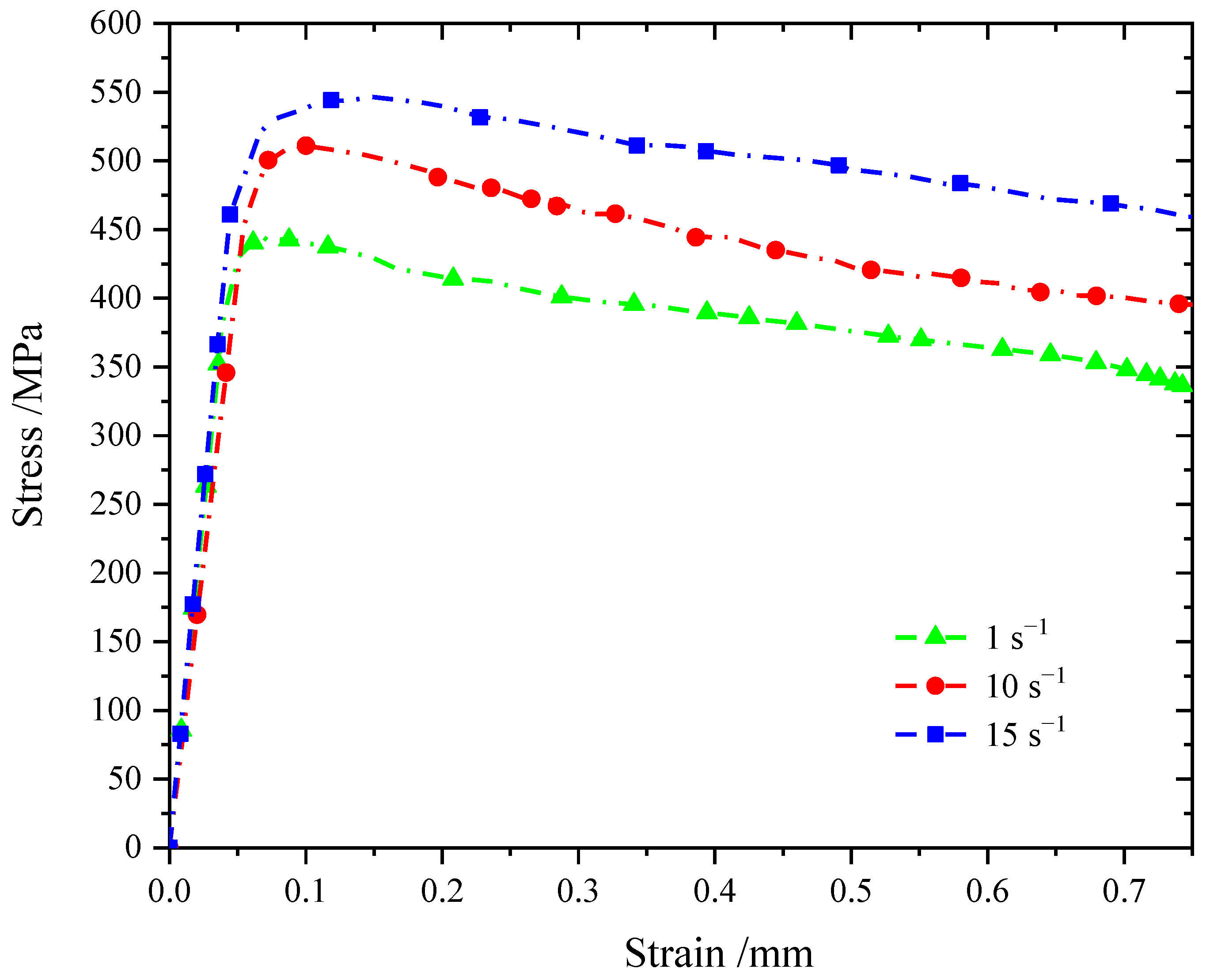

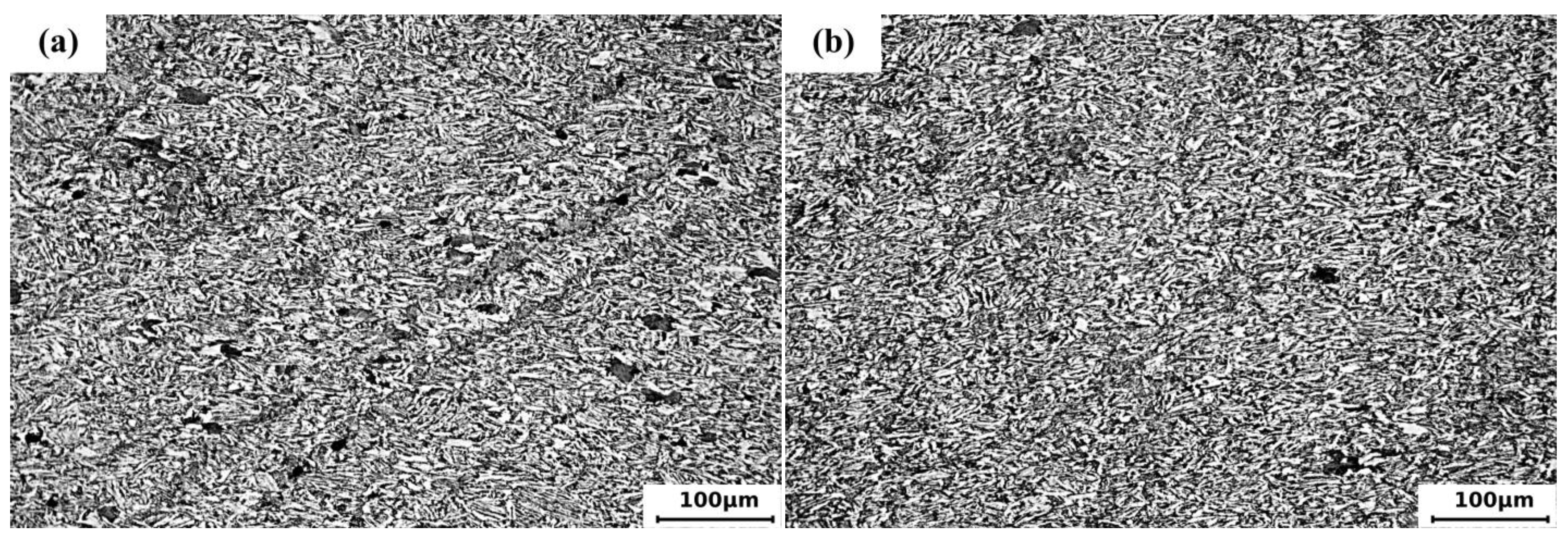
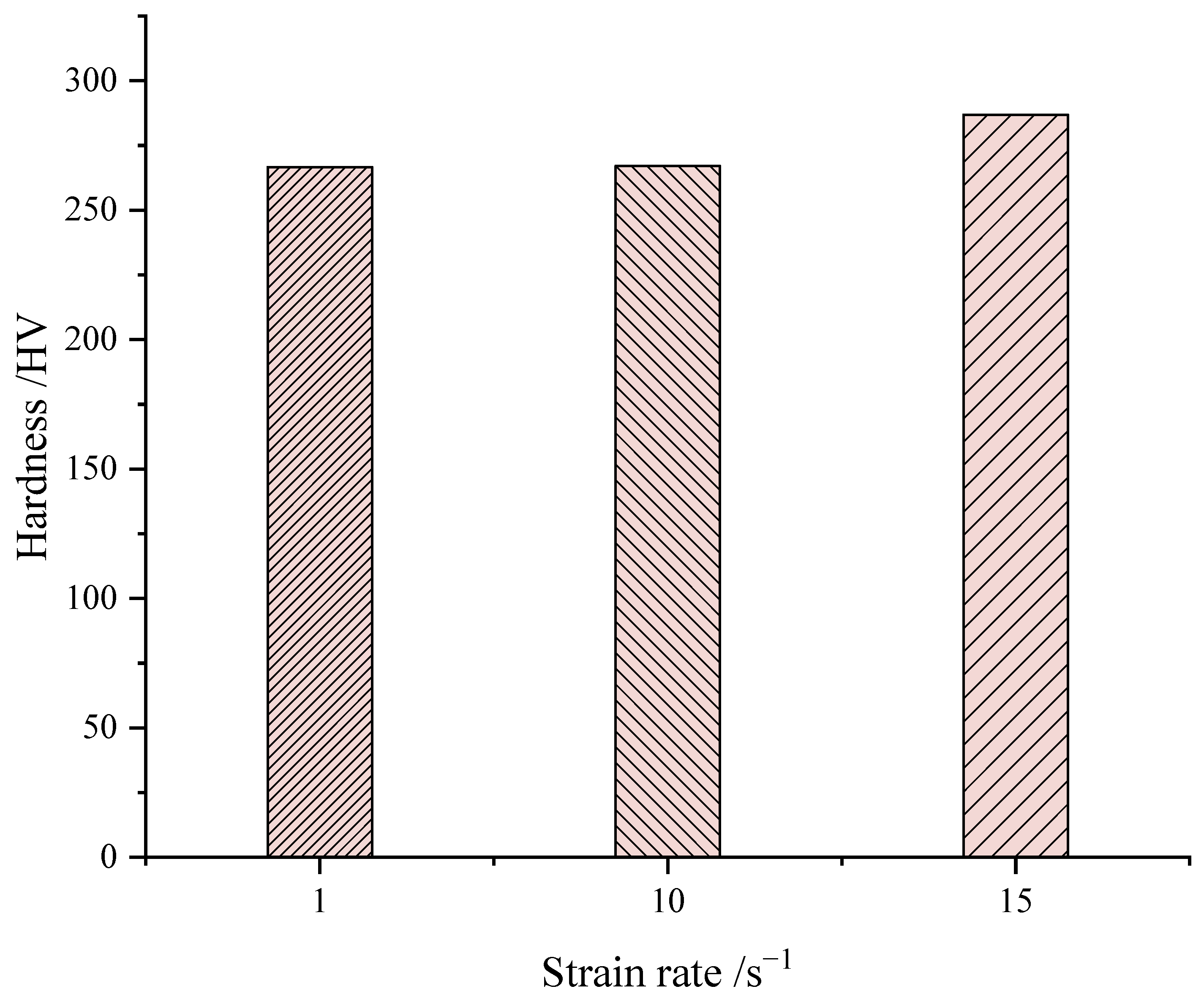
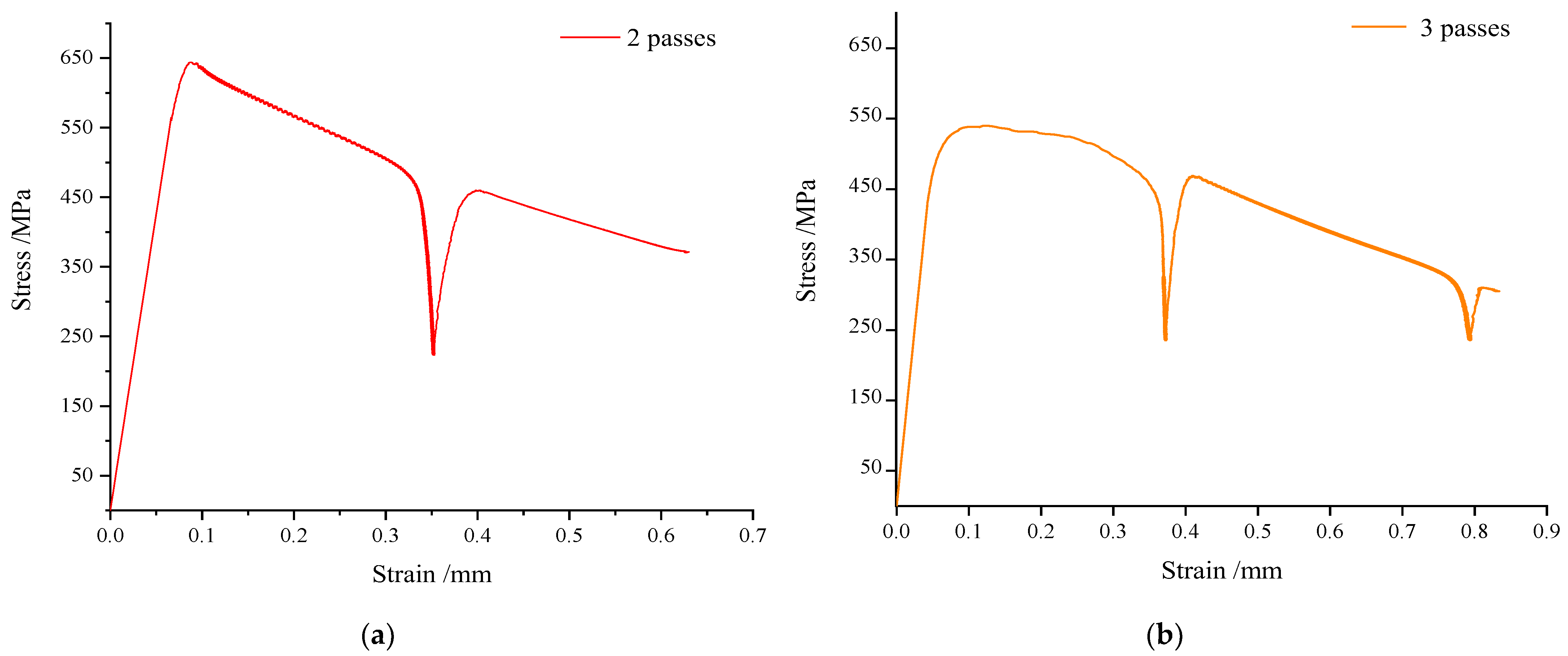

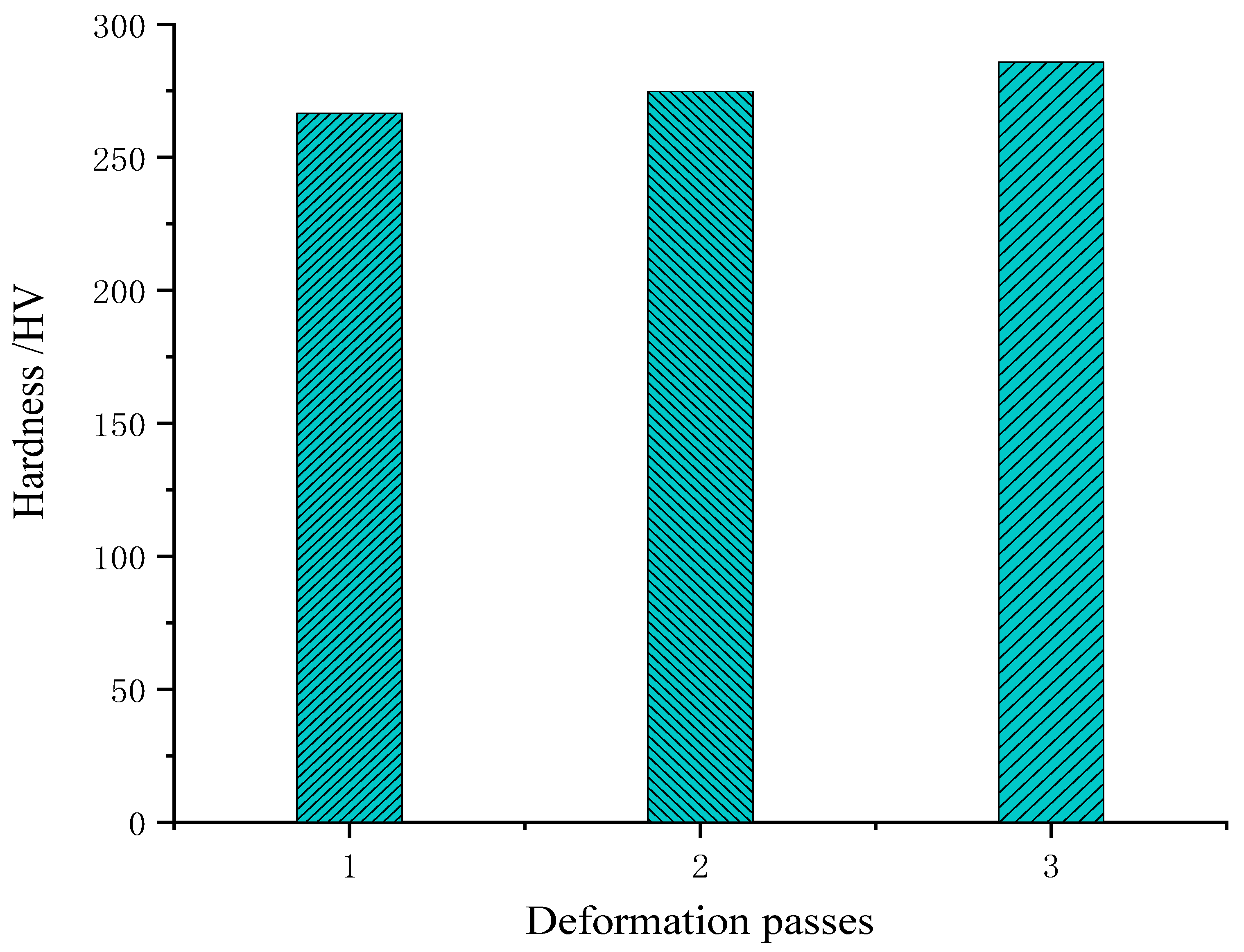
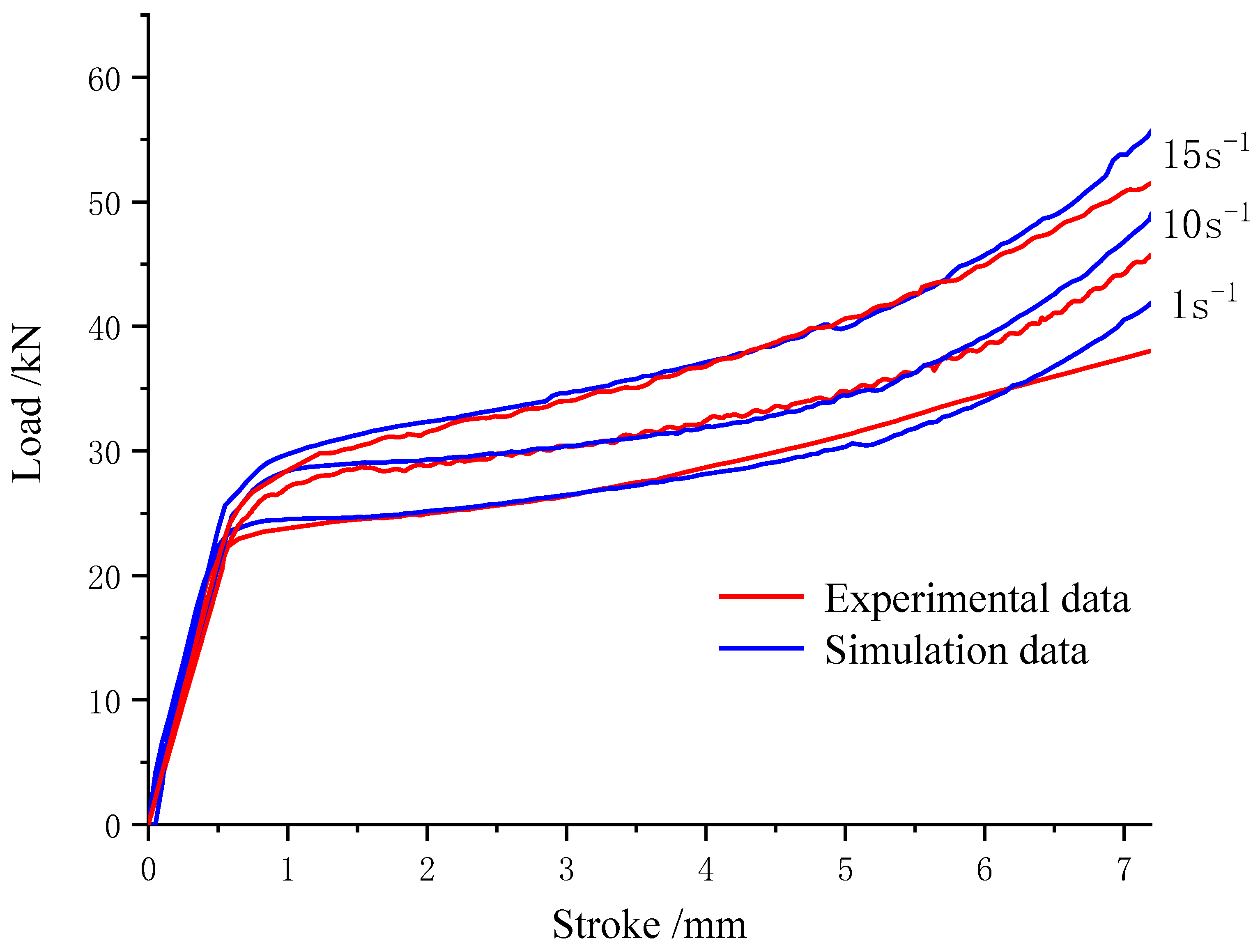
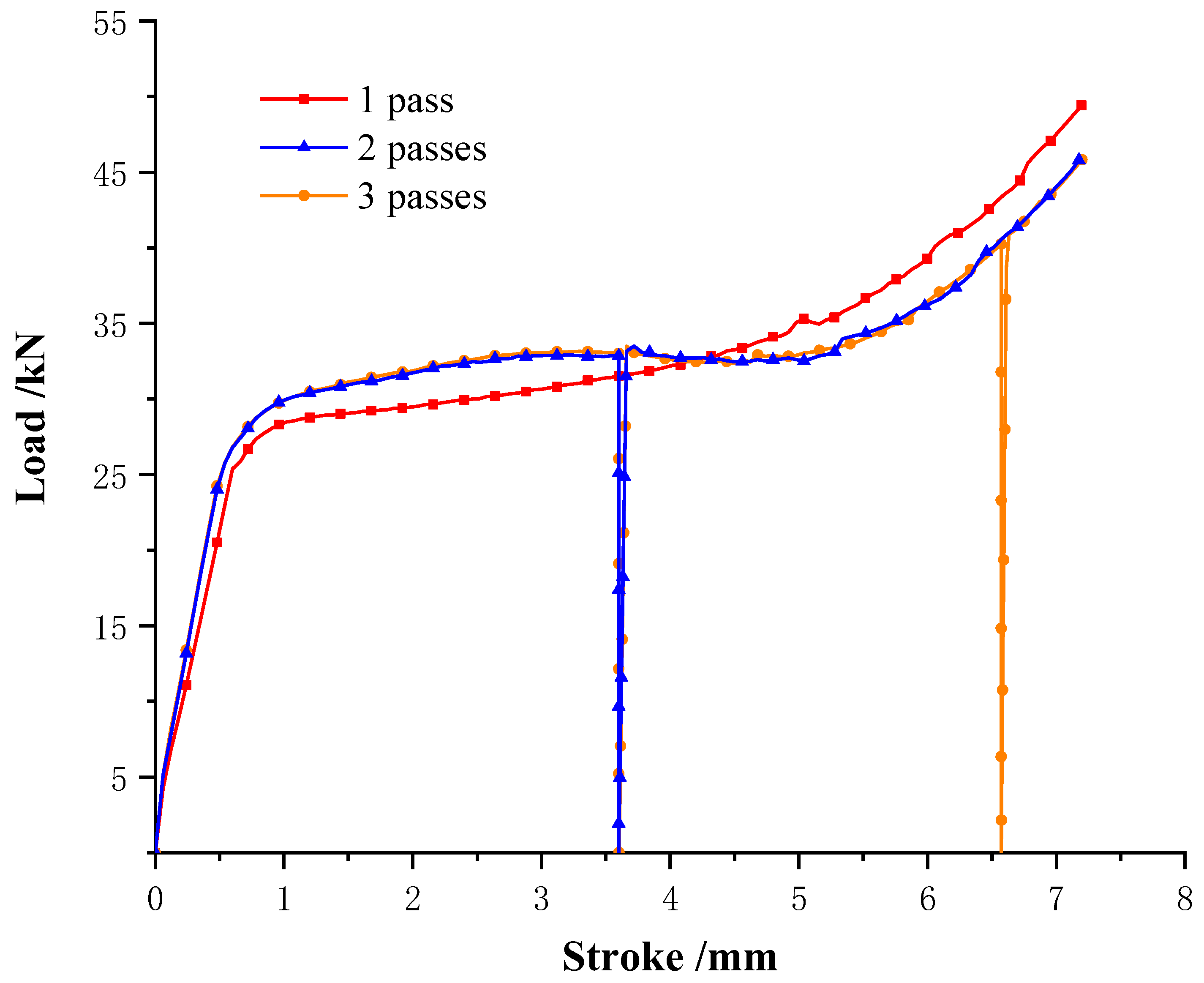
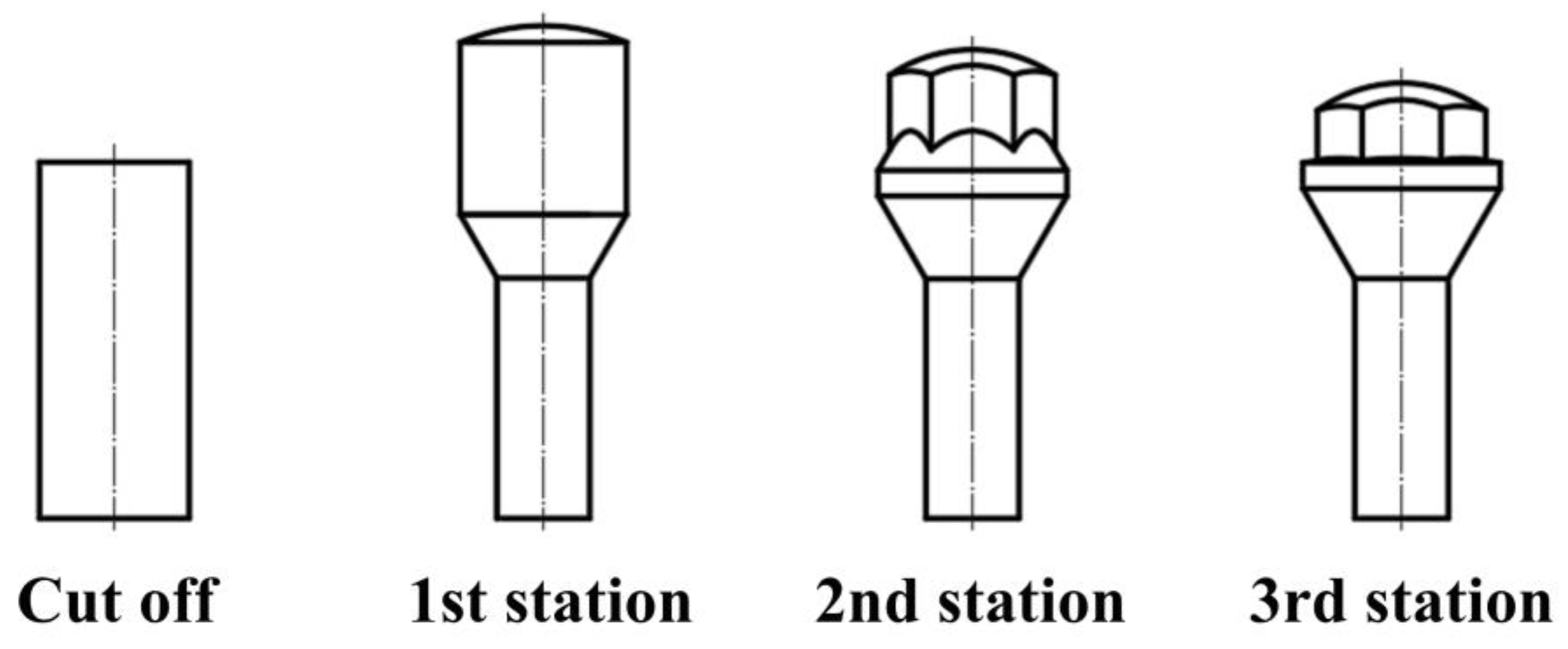

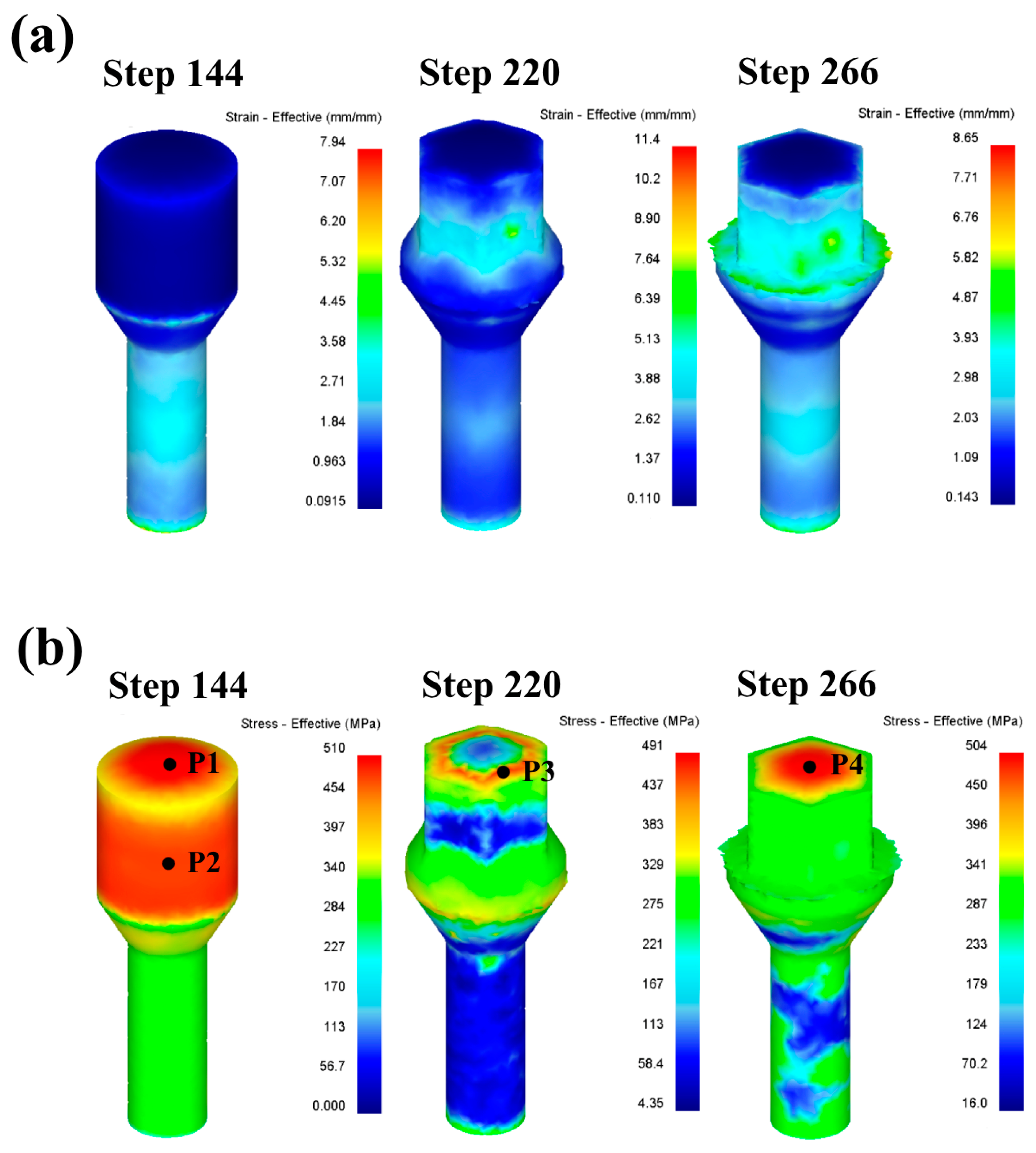
| Deformation Temperature (°C) | Strain Rate (s−1) | Deformation Amount (%) |
|---|---|---|
| 20 | 1 | 60 |
| 500 | 1 | 60 |
| 650 | 1 | 60 |
| 800 | 1 | 60 |
| 650 | 10 | 60 |
| 650 | 15 | 60 |
| Total Number of Deformation | Number of Deformation | Deformation Amount (mm) | Strain Rate (s−1) | Deformation Temperature (°C) |
|---|---|---|---|---|
| 2 | 1 | 3.6 | 10 | 650 |
| 2 | 3.6 | 10 | 650 | |
| 3 | 1 | 3.6 | 10 | 650 |
| 2 | 2.94 | 10 | 650 | |
| 3 | 2.184 | 10 | 650 |
Disclaimer/Publisher’s Note: The statements, opinions and data contained in all publications are solely those of the individual author(s) and contributor(s) and not of MDPI and/or the editor(s). MDPI and/or the editor(s) disclaim responsibility for any injury to people or property resulting from any ideas, methods, instructions or products referred to in the content. |
© 2024 by the authors. Licensee MDPI, Basel, Switzerland. This article is an open access article distributed under the terms and conditions of the Creative Commons Attribution (CC BY) license (https://creativecommons.org/licenses/by/4.0/).
Share and Cite
Xiao, Z.; Wang, H.; Liu, J.; Jiang, J.; Yu, L.; Zhang, Y. Study on Deformation Behavior and Mechanical Properties of 42CrMo High-Strength Steel with Multi-Station Warm Upsetting. Metals 2024, 14, 135. https://doi.org/10.3390/met14020135
Xiao Z, Wang H, Liu J, Jiang J, Yu L, Zhang Y. Study on Deformation Behavior and Mechanical Properties of 42CrMo High-Strength Steel with Multi-Station Warm Upsetting. Metals. 2024; 14(2):135. https://doi.org/10.3390/met14020135
Chicago/Turabian StyleXiao, Zhiling, Hao Wang, Jinhua Liu, Junjie Jiang, Liming Yu, and Yuhao Zhang. 2024. "Study on Deformation Behavior and Mechanical Properties of 42CrMo High-Strength Steel with Multi-Station Warm Upsetting" Metals 14, no. 2: 135. https://doi.org/10.3390/met14020135
APA StyleXiao, Z., Wang, H., Liu, J., Jiang, J., Yu, L., & Zhang, Y. (2024). Study on Deformation Behavior and Mechanical Properties of 42CrMo High-Strength Steel with Multi-Station Warm Upsetting. Metals, 14(2), 135. https://doi.org/10.3390/met14020135








